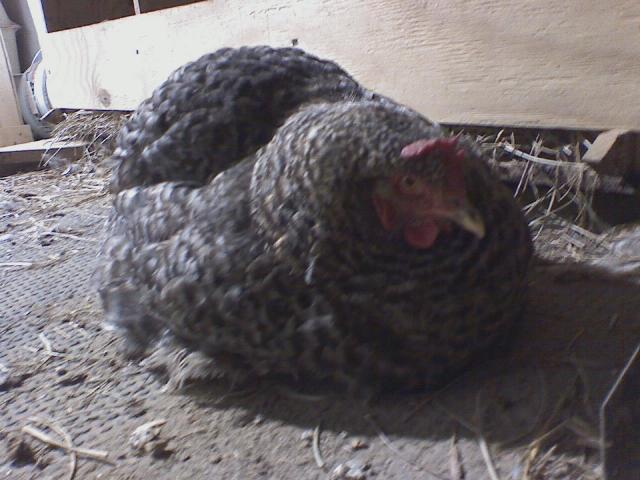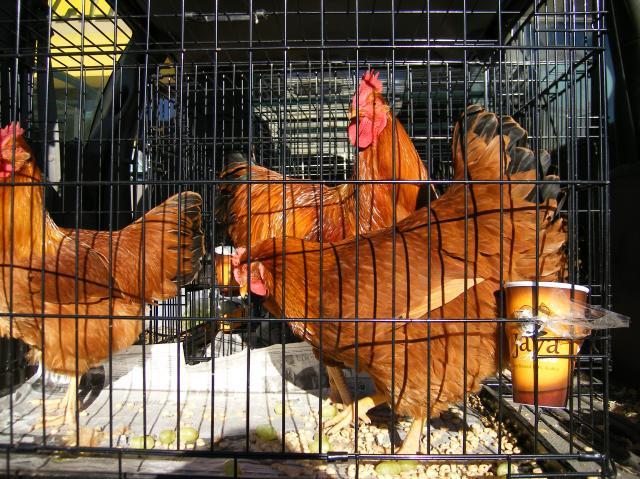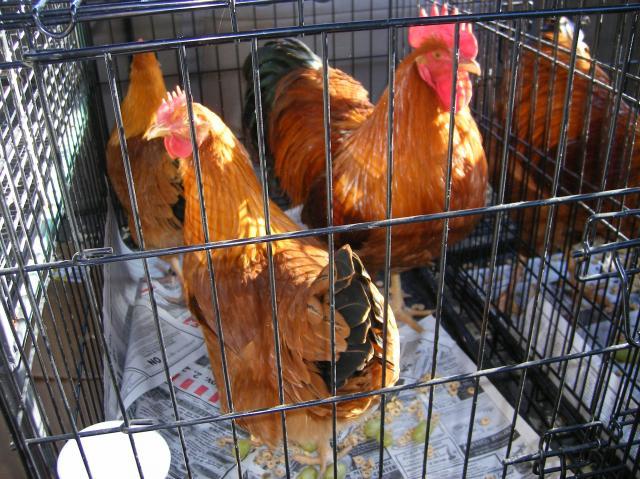So sorry you lost her. You sure are a great mom to your chicken. I am sure they know you love them very much as you give them such great care when they are with you.
Navigation
Install the app
How to install the app on iOS
Follow along with the video below to see how to install our site as a web app on your home screen.
Note: This feature may not be available in some browsers.
More options
You are using an out of date browser. It may not display this or other websites correctly.
You should upgrade or use an alternative browser.
You should upgrade or use an alternative browser.
Sdwd
- Thread starter Yard full o' rocks
- Start date
Quote:
I agree about those dolls!
 (Especially the Chuckie doll)
(Especially the Chuckie doll)
I know exactly what you are saying about loving those chickens, too! Just can't get enough of them! My Delaware girls are the best layers I have, and I have quite a few breeds. When spring gets here, I'm gonna send you some more chicks to brood, too!

I agree about those dolls!

I know exactly what you are saying about loving those chickens, too! Just can't get enough of them! My Delaware girls are the best layers I have, and I have quite a few breeds. When spring gets here, I'm gonna send you some more chicks to brood, too!

Lost Olivia today
So sorry, Cyn.

So sorry, Cyn.

So sorry to hear that Cyn.

Hopefully that was the last loss you will have for a while. That was the last of the hens having issues, right?
I went into the garage today and that big rir/cochin hen screamed at me when i walked in, so i figured she must have another chick under her. Yep, another yellow one hatched out.....so I pulled it out and gave it to the banty cochin hen. There are only 2 non-green eggs left under her and 1 is the light test egg from 10/24.....so only 1 more possible 'early chick'.
The barred cochin is still broody. I threw her out into the yard this morning but she was back in the garage nestbox tonight. She was VERY ANGRY with me when i moved her.
Very. Very. Angry.
She is a good broody. BIG and fluffy and one of my original hens so very high up the totem pole and the other hens know it. She gets zero problems from the rest of the flock when she has babies.

I took her out of the nest box and set her down for a minute so i could then go put her in the garage for tonight.

Very. Angry. Broody.

Hopefully that was the last loss you will have for a while. That was the last of the hens having issues, right?
I went into the garage today and that big rir/cochin hen screamed at me when i walked in, so i figured she must have another chick under her. Yep, another yellow one hatched out.....so I pulled it out and gave it to the banty cochin hen. There are only 2 non-green eggs left under her and 1 is the light test egg from 10/24.....so only 1 more possible 'early chick'.
The barred cochin is still broody. I threw her out into the yard this morning but she was back in the garage nestbox tonight. She was VERY ANGRY with me when i moved her.
Very. Very. Angry.
She is a good broody. BIG and fluffy and one of my original hens so very high up the totem pole and the other hens know it. She gets zero problems from the rest of the flock when she has babies.

I took her out of the nest box and set her down for a minute so i could then go put her in the garage for tonight.

Very. Angry. Broody.
Janelle, as far as I know, Olivia is the last one with internal laying issues, though, I have several hens who have not laid an egg for awhile. They're molting, plus are about to turn five years old, so no idea if there will be problems with those ladies. So many of mine, most, in fact, are not laying at all. So, yes, that is the last one I was aware had internal issues. Olivia was the best little hen you could imagine, a fabulous broody, sweet natured, very friendly, loved just to sit on my lap and let me talk to her. Her sisters were the same way. She almost made it to four years old--she and her sisters were hatched with Suede.
I saw on the other thread that you would need a silkie/cochin x barred rock to creat more poufy headed sisters. I just happen to have a silkie/cochin hen (buff and cuuuuuuuute, bearded and everything).....but no rocks. I could make you sort of similar poofy headed chickens. Maybe crossed with a cochin or ameracuana....? If you wanted a set of hatching eggs in spring, let me know and i can do some rearranging. Or silkie/cochin X golden campine. THAT would be strange, yet interesting.
Last edited:
Quote:
Aw, she sounds like a great little hen. Hopefully your other girls are just doing the usual molting/seasonal slacking.....
Aw, she sounds like a great little hen. Hopefully your other girls are just doing the usual molting/seasonal slacking.....
Home from driving 650 miles today.

I got my 2 trios of New Hampshires!




I got my 2 trios of New Hampshires!



Oooh Kathy, those are nice and pretty! Love that color.
Wow, they're gorgeous, Kathy! You are one determined woman!
Janelle, I may end up having a Silkie around here--yeah, I know, my reputation will be absolutely in the toilet, but if these only one or two Dels hatch, I may see if the feed store has a bantam I can add in as a buddy...and the last batch I saw were mostly Silkies.
Janelle, I may end up having a Silkie around here--yeah, I know, my reputation will be absolutely in the toilet, but if these only one or two Dels hatch, I may see if the feed store has a bantam I can add in as a buddy...and the last batch I saw were mostly Silkies.
The pictures do not do them justice. They are sooooo gorgeous, really. I am excited to have them. This stock came from Germany.
The history of the Hampshire, I found while searching, is ....
The New Hampshire Red Chicken takes its name from the State of New Hampshire in the U.S which neighbours the State of Rhode Island that developed the well known Rhode Island Red (RIR). It was developed initially as a commercial breed by Professor 'Red' Richardson, a poultry lecturer at the University of New Hampshire around 1918 from selected strains of RIR, without introducing any other breed. He was trying to improve upon some of the qualities of the RIR to improve profitability of the broiler industry that was starting to evolve locally to supply the markets of New York. He ignored colour and kept selections of slightly different colour varieties, primarily selecting for faster feathering birds which meant they would retain heat and increase feed conversion. Good hatchability of eggs was another one of his selection criteria which in the days where incubators were still new on the market and could be somewhat temperamental, was necessary for farms to be successful. During the 1920's, many farms took them up and during the mid-1930's the New Hampshire Red reached the U.K. They were used as a commercial bird by a handful of farms but the RIR was more popular being used after the war as a hybrid cross with the Light Sussex. Along with a few other breeds (like the Plymouth Rock / Amrock, they were introduced into Germany as part of the post war reconstruction efforts. They became popular in Germany and the Netherlands, as exhibition birds during the 70's and by the 1980's they started to gain popularity in the U.K. They joined the Rare Poultry Society until 1997 when the New Hampshire Red Poultry Club was formed.
The RIR is distinctly different in both colour and type to the Rhode Island Red and the differences in colour are clearly defined. The New Hampshire Red was first standardised by the American Poultry Association in 1935, some years after its creation. There are two very rare colour varieties that are not standardised in the U.S or U.K, these are Blue Tailed New Hampshire Reds (created in the Netherlands during the late 1980's) and New Hampshire Whites (created by crossing New Hampshire Reds with White Barnevelders during the early 1950's in Germany). Very little has been found about these and if you have any information or photos of these, we would be interested to speak with you.
The history of the Hampshire, I found while searching, is ....
The New Hampshire Red Chicken takes its name from the State of New Hampshire in the U.S which neighbours the State of Rhode Island that developed the well known Rhode Island Red (RIR). It was developed initially as a commercial breed by Professor 'Red' Richardson, a poultry lecturer at the University of New Hampshire around 1918 from selected strains of RIR, without introducing any other breed. He was trying to improve upon some of the qualities of the RIR to improve profitability of the broiler industry that was starting to evolve locally to supply the markets of New York. He ignored colour and kept selections of slightly different colour varieties, primarily selecting for faster feathering birds which meant they would retain heat and increase feed conversion. Good hatchability of eggs was another one of his selection criteria which in the days where incubators were still new on the market and could be somewhat temperamental, was necessary for farms to be successful. During the 1920's, many farms took them up and during the mid-1930's the New Hampshire Red reached the U.K. They were used as a commercial bird by a handful of farms but the RIR was more popular being used after the war as a hybrid cross with the Light Sussex. Along with a few other breeds (like the Plymouth Rock / Amrock, they were introduced into Germany as part of the post war reconstruction efforts. They became popular in Germany and the Netherlands, as exhibition birds during the 70's and by the 1980's they started to gain popularity in the U.K. They joined the Rare Poultry Society until 1997 when the New Hampshire Red Poultry Club was formed.
The RIR is distinctly different in both colour and type to the Rhode Island Red and the differences in colour are clearly defined. The New Hampshire Red was first standardised by the American Poultry Association in 1935, some years after its creation. There are two very rare colour varieties that are not standardised in the U.S or U.K, these are Blue Tailed New Hampshire Reds (created in the Netherlands during the late 1980's) and New Hampshire Whites (created by crossing New Hampshire Reds with White Barnevelders during the early 1950's in Germany). Very little has been found about these and if you have any information or photos of these, we would be interested to speak with you.
New posts New threads Active threads
-
Latest threads
-
-
-
Frothy eye, sneezing, wet nose - treatment help
- Started by Webbykins
- Replies: 0
-
-
-
-
Threads with more replies in the last 15 days
-
There is a time and place for shenanigans. (edit: THIS is that time and place)
- Started by azurbanclucker
- Replies: 390
-
Caged Bird and Parrot Thread!!!!
- Started by ShrekDawg
- Replies: 251
-
-
-
Open Contest BYC's 4th of July Star Spangled Hatch-Along—Stars, Stripes, & Feathers, a Text-to-Image Contest
- Started by Debbie292d
- Replies: 129
-



